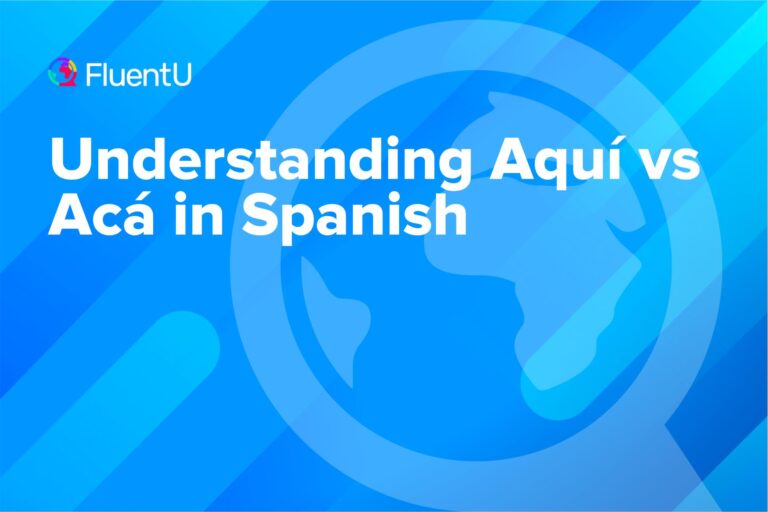Spanish Cases in Grammar and Their Role in Spanish Sentences

Why do you need to know the grammatical labels for every sentence part in Spanish? Well… you don’t, except for in those awkward moments when you get them mixed up. Did you really mean to say “Me give the letter to he?” in Spanish? Probably not.
But if you knew all about Spanish cases, you wouldn’t make that kind of mistake. We’re here to help you get a handle on Spanish cases.
Download: This blog post is available as a convenient and portable PDF that you can take anywhere. Click here to get a copy. (Download)
The Spanish Cases
Nominative Case
In this case, the noun or pronoun functions as the subject of the sentence. In other words, it’s the person, place or thing doing the action, like the word “dog” in this sentence: “The dog drinks the water.”
The pronouns used in the Spanish nominative case are the standard ones that are typically the first ones you learn.
Yo — I
Tú/vos — You (informal)
Usted — You (formal)
Él — He
Ella — She
Nosotros/nosotras — We
Vosotros/vosotras — You (plural, informal)
Ustedes — You (plural, formal)
Ellos — They (masculine)
Ellas — They (feminine)
Here are a couple of example sentences:
Los profesores (ellos) les dan los libros. — The professors (they) give them the books.
Yo voy a la biblioteca. — I go to the library.
Nosotros comemos siempre. — We always eat.
Accusative Case
Nouns in the accusative case are direct objects, meaning they directly receive the action of the verb. In our example sentence from the last section, the water is the direct object: “The dog drinks the water.”
The Spanish pronouns used in the accusative case are:
Me — me
Te — you (relating to tú)
Lo — him, it (masculine) and you (relating to usted)
La — her, it (feminine) and you (relating to usted)
Nos — us
Os — you (relating to vosotros and vosotras)
Los — them (masculine) and you (relating to ustedes)
Las — them (feminine) and you (relating to ustedes)
In the sentence Yo quiero helado (I want ice cream), the helado is in the accusative case since it’s receiving the action of “being wanted.” Notice that the noun doesn’t change.
If we replaced it with a pronoun, though, you’d change helado to lo since el helado is a masculine noun. The resulting sentence would look like this: Yo lo quiero (I want it).
Some other examples:
Yo lo veo. — I see it.
Mi hermana nos enseña. — My sister teaches us.
Dative Case
Nouns in the dative case refer to indirect objects. They indirectly receive the action of a sentence. In the sentence “I talked to him,” the word “him” is in the dative case since the action of being “talked to” is being received by “him.” If the sentence were “I asked him,” then “him” would be in the accusative case since the action is being applied directly!
Confused? Don’t be! Think of indirect objects as nouns or pronouns that are being acted on, to, for, forward, on behalf of, etc. There’s a degree of separation, usually indicated by a preposition in English.
The Spanish pronouns for the dative case are:
Me — me
Te — you (informal)
Le, se — him, her, it or you (formal)
Nos — us (formal)
Vos — us (informal)
Les, se — you (formal)
Les, se — them
Let’s return to this example sentence: Los profesores les dan los libros. In this sentence, the les is in the dative case, showing that the professors give the books “to them.”
Some other examples:
Yo doy el regalo a mi padre. — I give the present to my father.
Yo le doy el regalo. — I give him the present. (“I give the present to him.”)
Mi hermana escribe a su amigo. — My sister writes to her friend.
Mi hermana le escribe. — My sister writes to him.
Wait, but when do you use se? This little pronoun is reserved for those moments when a pronoun in the accusative case (a direct object) wants to join a pronoun in the dative case (an indirect object).
If we wanted to change the los libros to a pronoun in this sentence Los profesores les dan los libros, we’d also have to change les to se:
Los profesores se los dan. — The professors gave them (the books) to them (the people).
Just remember that the indirect object pronoun—that is, the pronoun in the dative case—always comes before the direct object pronoun.
Genitive/Possessive Case
This case denotes objects which are owned or possessed by someone. In other words, “mine” is in the genitive/possessive case in this example: “This is mine!”
The genitive case pronouns in Spanish are gendered. That is, you need to take into account the gender of the person you’re referring to when you’re choosing which pronoun to use:
mío(s), mía(s) — mine
tuyos(s), tuya(s) — yours (corresponding to tú)
suyo(s), suya(s) — his, hers or yours (corresponding to usted)
nuestro(s), nuestra(s) — ours
vuestro(s), vuestra(s) — yours (corresponding to vosotros/vosotras)
suyo(s), suya(s) — theirs, or yours (corresponding to ustedes)
This case is used basically the same in Spanish as it is in English so it shouldn’t give you too much trouble. Here are some examples:
El chocolate no es tuyo. Es mío. — The chocolate isn’t yours. It’s mine.
Los libros son suyos. — The books are theirs.
Son nuestros amigos.— They are our friends.
If you want to use the possessive case with a noun (ie “my item”), you’ll need to also learn a few possessive adjectives. That topic is too broad for our little post but you can learn a lot more about possessive adjectives in Spanish with our guide. The Spanish possessive adjectives are as follows:
mi(s) — my
tu(s) — your (informal)
su(s) — his, her, their, its, your (corresponding to usted)
nuestro(s)/nuestra(s) — our
vuestro(s)/vuestra(s) — your (corresponding to vosotros/vosotras)
Use the -s form of the possessive pronoun when the noun attached to it is plural. Here are a few examples:
Tienes mi móvil.— You have my phone.
¿Vas a comer tus papas fritas? — Are you going to eat your french fries?
Why Do Spanish Cases Matter?
Even if you don’t need to alter words to make them fit into a case, knowing what function a word is serving in a sentence can be quite beneficial.
Here are all the reasons why Spanish cases matter:
- They tell you how a noun functions in a sentence. Nouns don’t change for Spanish cases, but pronouns and subject markers do, so being able to tell what case a noun is in will help you if you decide to turn it into a pronoun.
- Cases help you understand which pronoun to use. What student of Spanish hasn’t gotten tripped up with the difference between lo and le? Or struggled with the four different possible words for “mine”? Understanding Spanish cases takes the mystery out of the plethora of pronouns that exist.
- They help determine word order in a sentence. Word order in any language is one of the hardest things to learn. It’s a lot to keep track of. But a little practice with Spanish cases can help you keep everything straight.
How to Practice Spanish Cases
As with anything, the best way to master Spanish cases is to practice them. Here are some of the best ways to do that:
Converse with a native speaker
The best way to understand how to use Spanish cases correctly is to hear and use them in conversation.
After all, when you were learning to speak your first language, no one had to explain anything to you about pronouns, cases or word order. Over time, you just figured out that certain sentences just “sounded” right. It’s the same with Spanish.
Do some online grammar exercises
There’s nothing like repetition to really drive a grammar point home.
Here are some good sites to drill Spanish cases.
- Study Spanish offers hands-on practice with almost any grammar topic you could imagine, including Spanish cases. Check out Unit 4 for some practice with different kinds of pronouns, and Unit 8 for correct word order in statements of command. Unit 1 gives you a run-down of gender and correct use of subject pronouns.
- Lengalia’s second level in its Spanish course provides a thorough review of Spanish modality and verbs.
Do listening exercises with captions
Watching videos with subtitles is like listening to a conversation, but with the added benefit of seeing the words at the same time. This allows you to practice reading and listening simultaneously to get a real grasp of your Spanish cases.
Here are the best sites to practice listening to sentence structure.
- Netflix has a nice variety of Spanish movies and Spanish TV shows. All you have to do is go into your settings to make sure there’s a checkmark next to “Spanish” for subtitles. You can pause and go back as many times as you need to understand the dialogue better. Plus, Netflix is generally a great tool to help you learn Spanish.
- FluentU is a language learning program that provides interactive dual-language subtitles for a range of Spanish video clips.
FluentU takes authentic videos—like music videos, movie trailers, news and inspiring talks—and turns them into personalized language learning lessons.
You can try FluentU for free for 2 weeks. Check out the website or download the iOS app or Android app.
P.S. If you decide to sign up now, you can take advantage of our current sale!

- FluentU Spanish YouTube channel. FluentU also has a YouTube channel where you can find in-depth Spanish video lessons using dubbed episodes of popular movies, TV shows and music videos. Like this one using an episode of “Breaking Bad”:
Or this episode of Futurama, if you prefer cartoons:
You now have a handle on Spanish cases and their roles in the Spanish sentence!
Download: This blog post is available as a convenient and portable PDF that you can take anywhere. Click here to get a copy. (Download)
And One More Thing…
If you've made it this far that means you probably enjoy learning Spanish with engaging material and will then love FluentU.
Other sites use scripted content. FluentU uses a natural approach that helps you ease into the Spanish language and culture over time. You’ll learn Spanish as it’s actually spoken by real people.
FluentU has a wide variety of videos, as you can see here:

FluentU brings native videos within reach with interactive transcripts. You can tap on any word to look it up instantly. Every definition has examples that have been written to help you understand how the word is used. If you see an interesting word you don’t know, you can add it to a vocab list.

Review a complete interactive transcript under the Dialogue tab, and find words and phrases listed under Vocab.

Learn all the vocabulary in any video with FluentU’s robust learning engine. Swipe left or right to see more examples of the word you’re on.

The best part is that FluentU keeps track of the vocabulary that you’re learning, and gives you extra practice with difficult words. It'll even remind you when it’s time to review what you’ve learned. Every learner has a truly personalized experience, even if they’re learning with the same video.
Start using the FluentU website on your computer or tablet or, better yet, download the FluentU app from the iTunes or Google Play store. Click here to take advantage of our current sale! (Expires at the end of this month.)








